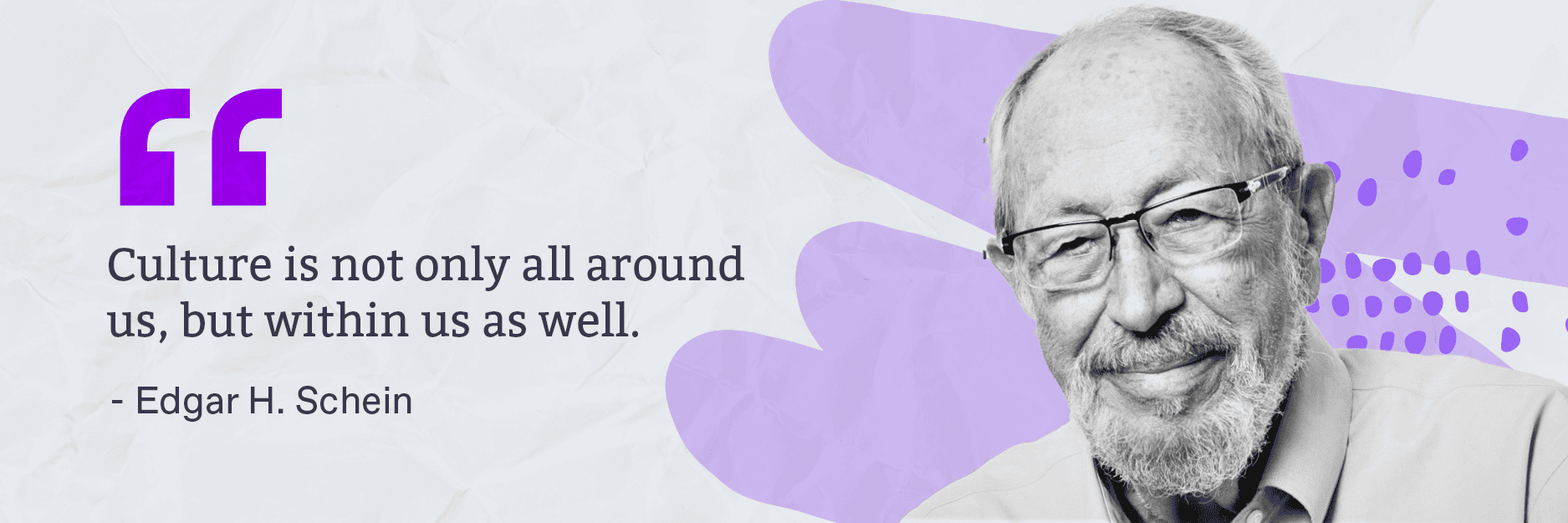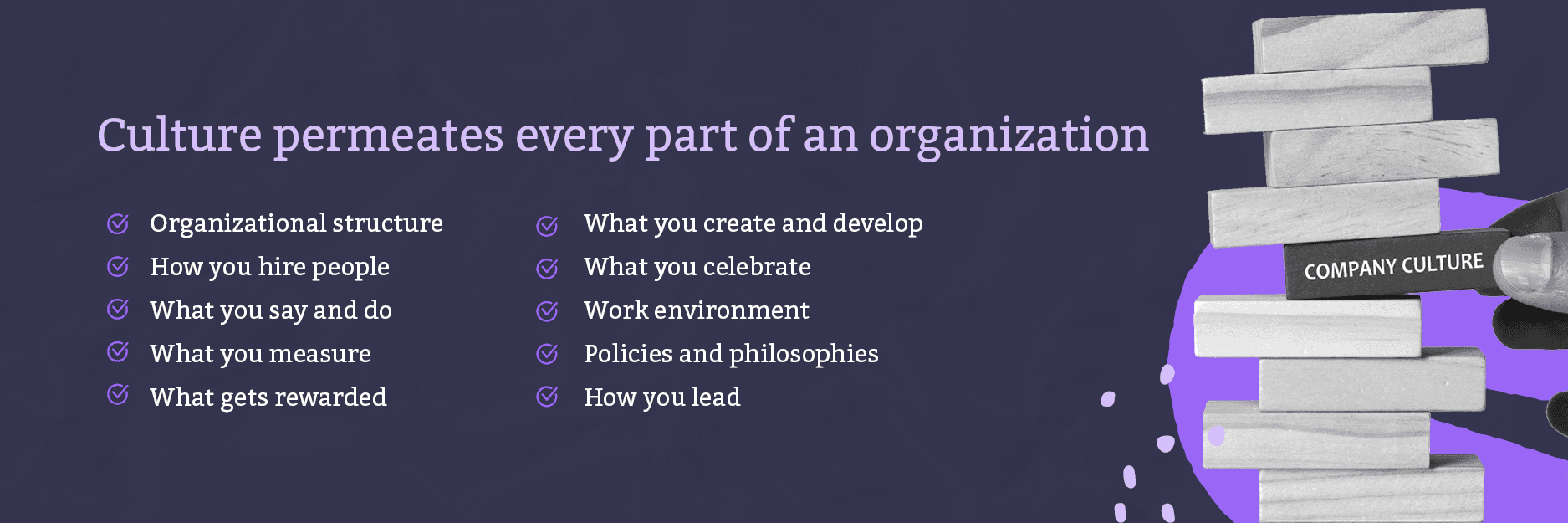Want To Finally Crack Company Culture? Context Is Everything!

Gillian French
Employee Experience Officer
August 9 2022

Company culture everywhere needs to evolve, and it’s time we let go of legacy in favor of context.
How do you define culture? Some call it the “character and personality of your organization”. To others, it’s the “result of the behavior of individuals, and not the other way around”.
One definition that sticks with me is Stan Slap’s, who was a guest on our Employee Experience Podcast recently.
Stan, a New York Times bestselling author, said: “[Culture] is asking what are the common beliefs about the rules of survival and emotional prosperity.”
Company culture is a business leader’s best friend
In order to maintain a healthy company culture, everyone needs to be obsessed with it. Everyone should feel like they own the culture and have personal accountability for its preservation.

All too often the culture is decided by the leadership team and cast down to the employees. This never works. It needs to be a collaborative effort and employees need to feel part of the process.
World-leading culture expert Edgar H. Schein says that “culture is not only all around us, but within us as well”.
We need to understand that every move our business makes is being monitored through the lens of our culture and assessed – mostly unconsciously – by teams.
What does this mean for our day-to-day? Every change initiative, every new process, and every significant event – such as mergers, acquisitions, and downsizing – needs to be done with complete consideration of the company culture and its impact.
If this is all sounding a bit oppressive, remember that culture, when done correctly, can be your biggest ally.
As Stan said, “The most important thing here is your culture will give you whatever you want. It’s not anti-management, it’s not anti-change; it’s just anti-unsafe. It will give you whatever you want – you just have to give it what it wants first.”

Where does change begin?
Over the years, I’ve seen firsthand the sale of and investment in organizations. It’s always baffled me that the people involved – the advisors, the acquirers – never asked any questions or raised any concerns about the company culture.
It’s widely viewed that company culture is a clear differentiator for a company’s success. And yet, the amount of investigation or due diligence it gets during the acquisition process is minimal.
As Stan told me, “From the enterprise perspective, the definition of a great culture is a committed culture. Because if your culture wants something to happen in your business, it’s going to happen. If it doesn’t want something to happen, nothing’s going to happen.”
There are lots of examples of organizations that have a cutting-edge, committed culture, such as Southwest Airlines and, more recently, HubSpot under its new CEO. One thing they’re all doing right is prioritizing culture ahead of time rather than treating it as an afterthought.
“The biggest metric a culture can show you won’t be seen unless your culture needs to show it,” Stan said. “If your company gets into trouble, only a committed culture will step up and save it.
“And so you can’t bank that kind of thing when you need it, you have to put it away ahead of time. This is not just about achieving performance, this is about achieving performance insurance.”
So the question remains: why don’t company boards question and monitor company culture?
In another podcast episode, I spoke to Inspiring Change founder Scott McInnes. Scott believes that to truly get board members on side with company culture, they need to be told a story.
“Give the nitty gritty of what’s working well, what isn’t working so well, and what are you doing about it?” he says. “[Culture] is such a cloudy, amorphous thing that people have trouble getting their arms around. Let’s bring a bit more practicality to it, make it a bit more real.
“Let’s put out a line of levers that we can pull to make our cultures more aligned and engaged and let’s work out the ones we need to pull first. That is a conversation that I’d want to be having with the board.”
The secret ingredient to a thriving company culture
Clearly, prioritizing and staying on top of company culture is key. But to breathe life into your culture, to really make it bloom, you need to inject it with energy and enthusiasm.

“The first thing you have to do is secure the energy of your culture,” Stan said. “Your culture’s an organism. Like any organism, it needs energy to survive, but it only has so much.
“Most of your culture’s energy is being used just to navigate through the day to try and confirm rules of survival and emotional prosperity in an environment it cannot reliably control or anticipate. So it’s exhausted all the time because that never stops for a culture.
“So anything else you want the culture to do – work harder, work different, work more, reattach – means you are focusing on what energy the culture has left over, which is usually a thin ozone layer of discretionary energy.
“Your culture will prioritize the use of that remaining energy to protect itself, not the company. So if you’re asking the culture to do something, if you’re going to step on the gas, make sure there’s fuel in the tank.”
It’s time to let go of legacy and consider context instead
All too often I see leaders and managers come into businesses wanting to implement the initiatives they feel had served them in their previous workplace. This is understandable, but when it comes to company culture, context is everything.
I’ve seen this trend do damage to company cultures, especially when the business is growing rapidly and trying to keep pace with the market and competitors. The sad truth is that if everything in the organization is not aligned with its culture and values, employees will end up working for a company they no longer recognize.
It’s an interesting conundrum. I have worked with and observed leaders who have left organizations due to their culture and how they operate, yet when they start in a new organization they reach for the same policies and processes that they were allergic to in the first place.
As leaders and employees, we need to preserve what is good and healthy in our organization at all times. If we believe something will erode the environment we have built, then it’s really important that we speak up.
Culture, like everything in life, is always changing. If leaders are able to read the context and are in tune with the business, they will know when it needs to evolve and adapt.
What Stan said about culture being a living, breathing organism resonated with me. I agree with him that culture is ever-evolving, a little like we do as humans: we start off as children where we try lots of new things and are free-spirited, like a start-up.
Then we become adolescents, which is the point where we need to grow up a little. During this time, the behaviors that were okay when we were children are no longer acceptable, much like in a medium-sized company.
Finally, when we get older we definitely can’t behave like we did when we were a child – but we do still have those ingrained family values of where we came from. This makes us never want to fully lose the essence that was so critical to the success of the business in its early years, but it’s critical that we apply that essence to our new context as an established company.

Wondering if it’s time to adapt?
If you’re wondering whether it’s time to adapt your company culture to a new context, the answer is almost certainly yes.
Building a culture of engagement makes a good start and also makes good business sense. Organizations need to be intentional about preserving their cultures, and this involves reviewing every aspect of how they do business on a regular basis.
This isn’t an easy task in our current context, a big part of which is HR burnout. Just 26% of HR professionals feel they have the resources they need to do their job and 73% say they don’t have the tools necessary to carry out their job effectively.
Scott McInnes sees these reviews as “cultural audits”, and he thinks they should be standard practice.
“I think every organization should be doing cultural audits to find out where we are today; to see what we’re doing really, really well and to hold up and celebrate that, but also to find out where the gaps are,” Scott said.
“If you don’t know something is wrong, you can’t fix it. That’s a fact.”
It can be as simple as setting aside an hour a week to ring people and check how they’re doing, he added. But leaders also need to set out clear values and build their company’s culture around those with integrity; they need to do what they say they’re going to do.
“That is so important,” he said. “If that’s not there, nothing else works. [Leaders] do way more damage to put [values] up there and then not live them.”
‘Culture eats strategy for breakfast’
Companies also need to start viewing culture as a critical business asset. I truly believe that company culture is the only form of sustainable competitive advantage that an organization has.
Consider your competitors. If they really want to, they can figure out and imitate your technology and processes, but they will never be able to replicate your company culture. It’s so important to create a good one. And if you do, hold onto it for dear life!

Globally, the corporate culture needs a serious rethink. It is fast-paced, competitive, and obsessed with scale and growth at all costs. It celebrates transactional work and an always-on environment, driving and pushing teams rather than leading them.
What should it look like instead? Here’s what I think: it needs to be collaborative, people-first, strategic, focused on the long term, sustainable, resilient, and aligned with social impact.
Of course, leaders who want to lead and build organizations in new and different ways have their work cut out for them. I have observed really great leaders wanting a different outcome for their business – wanting a more people-focused, healthy culture – who haven’t been able to break free from the status quo.
To help, I think every leader should try to keep my favorite Peter Drucker quote in mind – that “culture eats strategy for breakfast”. Let’s make culture our North Star and the rest will follow. Under its guidance, our best approach to areas like strategy, business operations, and company objectives is bound to come to light.